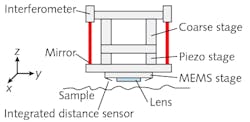Lens Actuators: 'Meta instrument' positioning platform for hyperlenses aims for industry
Several optical superresolution concepts, including hyperlenses, superoscillatory lenses, and nanoantennas, along with other high-resolution optical arrangements like solid immersion lenses (SILs), aim to allow users to image micro- and nanoscopic objects at higher resolutions than can be achieved with even the best conventional microscopes. They do this either by improving on ordinary optical configurations (SILs) or by circumventing the diffraction limit by using near-field imaging and other exotic approaches. The idea is that one day, at least some of these techniques could be available to industry as well as to the lab-equipment-tweaking researcher.
However, these new approaches all share one problem: the optics have to be positioned within tens of nanometers of the specimen to be examined. This is difficult enough for the lab tweaker to achieve, let alone for use in industry (for example, in semiconductor lithography). So researchers from the Netherlands Organisation for Applied Scientific Research and Delft University of Technology (both in Delft, Netherlands) are working on an optics positioning system, which they call a "meta-instrument," that will have subnanometer positional precision and a 100 kHz bandwidth.1
As would any optics positioning and focusing system, the meta-instrument must keep the optical element at the proper distance from the sample, even as the optics are scanned across the sample's varied topography. Most importantly, it must do this with enough precision to avoid contact with the sample. In addition, it has a tip-tilt function that is operative even during scanning.
For the optics that will be positioned by the meta-instrument, a typical field of view is on the order of 10 × 10 μm (with a total optical element size on the order of 1 × 1 mm), leading to a 1 μrad or better tip-tilt precision requirement. The desired lateral scan speed of at least 1 mm/s leads to the 100 kHz required bandwidth for the focusing system.
Optics integrated into MEMS stage
The meta-instrument is a combination of three positioning stages: a three-actuator coarse stage (producing translation plus tip-tilt) and a three-actuator fine piezo stage, the combination of which is monitored position-wise by three interferometers adjacent to the actuators, as well as a high-speed microelectromechanical-systems (MEMS) stage on which, for example, a hyperlens could be fabricated in the same process that is used to create the MEMS device (see figure). The motion of the MEMS stage is measured by a capacitive sensor.
Controlling the stages is done by taking into account the inputs from all the sensors to simultaneously drive the combination of the multiple actuators. An "offloading" approach is used, in which the fast control loops for the MEMS and piezo stages are nested in a slow control loop for the coarse stage.
The researchers built a first-generation prototype in which the coarse stage had a stroke of a few millimeters, a micrometer step size, and a 1.5 mm/s speed. The fine piezo stage had a control bandwidth of about 10 kHz. A fiber-optic interferometer with three interference signals was used for compactness—while the interferometer had a large drift of 70 nm over 1000 s, improvements will reduce this to 10 nm over the same time span.
The 150 × 150 μm electrostatically actuated MEMS device, which was 2 μm thick and made of silicon carbide, included a 40 × 40 μm optical element (a transparent window) integrated with the MEMS structure during manufacture of the MEMS device. In future systems, the transparent window would be replaced by the optics of choice.
A second-generation experimental device was built in which the functions of the coarse and piezo stages were combined, reducing the length and the moving mass of the instrument. Initial tests of one of the three actuators for the combined stage showed a step size of 0.32 μm, which at a 10 kHz drive rate results in a speed of 3.2 mm/s.
The second-generation meta-instrument has a 158 mm2 footprint, which means that 450 of these instruments could be packed together to simultaneously examine 450 sites on a 300 mm semiconductor wafer.
Because the embedded interferometer system itself cannot measure the distance from the lens surface to the sample, no system-wide data can yet be gathered in these devices. The addition of a sample-sensing system either next to or integrated into the optical element, or the addition of a point-probe stylus, will lead to a fully developed meta-instrument.
REFERENCE
1. R. J. F. Bijster et al., arXiv:1608.04281v1 [physics.ins-det] (Aug. 15, 2016).

John Wallace | Senior Technical Editor (1998-2022)
John Wallace was with Laser Focus World for nearly 25 years, retiring in late June 2022. He obtained a bachelor's degree in mechanical engineering and physics at Rutgers University and a master's in optical engineering at the University of Rochester. Before becoming an editor, John worked as an engineer at RCA, Exxon, Eastman Kodak, and GCA Corporation.
